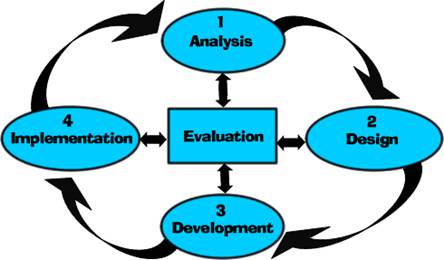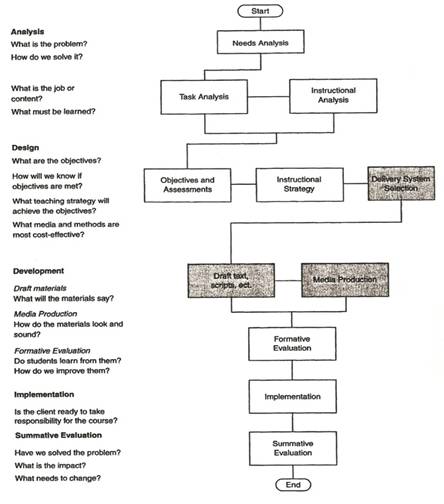Design | Development | Utilization | Management | Evaluation
Domain of Instructional Design
Utilizing systematic processes derived from well established theories and models is fundamental to the field of instructional technology, especially within the domain of design. The beginning of the design process involves a thorough analysis of a variety of information and is often referred to as a Front-End Analysis (FEA). This initial phase is absolutely essential for an effective design process, because it is where the problem is identified and also provides the basis on which the instructional designer will make their decisions regarding the instructional strategies and media selection (Seels & Glasgow, 1998).
When conducting a FEA, several pieces of information may need to be obtained, depending on the context of the situation and the scope of the project. This can be accomplished by conducting a series of analyses including: needs analysis, performance analysis, task analysis, learner and context analysis. These analyses will provide information pertaining to the:
- current and optimal system or process,
- available resources and constraints,
- target learner characteristics,
- tasks that are going to be taught and/or tasks that involve non-training related performance problems, and the
- environment or context where learners are performing tasks and where they will be taught (Dick, Carey & Carey, 2005).
If the project involves designing strategies and products for a large system like the military, then it is considered to be at the macro level, and may require more comprehensive analyses. On the other hand, if the project entails designing a unit of instruction or lesson plan, then it is at the micro level, and a less comprehensive analysis may need to be conducted (Seels & Glasgow, 1998).
Within the Domain of Instructional Design, there are four major theoretical and practical sub-domains, which encompass everything that an Instructional Technologist needs to design effective instructional materials. These sub-domains include: Instructional Systems Design, Message Design, Instructional Strategies and Learner Characteristics.
Instructional Systems Design (ISD)
Since the late 1960's, ISD has been the most widely used methodology
for developing instruction. The popularity of this approach is
due to its systematic process which incorporates learners’ needs,
design and development of instructional materials and evaluation of
the overall effectiveness of the program. There are many different
ISD models, but most of them based upon the generic model known by the
acronym ADDIE, which stands for Analysis, Design, Development, Implementation,
and Evaluation. As illustrated in figure 1,
each step produces an outcome that provides the foundation for the proceeding
step, except for evaluation which is involved throughout the process.
Seels and Glasgow (1998) expanded on the ADDIE model's five basic steps
by developing an ISD model geared toward novice instructional designers.
As illustrated in figure 2, their model provides
an easier way of breaking down the processes because it has more specific
steps than the ADDIE model, which can be followed by simply asking the
right questions.
Another ISD model that is commonly used is the Dick and Carey Systems Approach Model for Designing Instruction (Dick, Carey & Carey, 2005). Like the Seels and Glasgow model, the steps are broken down with explanations of how to proceed. The level of user-friendliness in Dick and Carey's model is what makes it a good model for beginning instructional designers who are trying to learn the ISD process. As illustrated in figure 3, one of the most important characteristics of these models, which is central to the effectiveness of the instructional product, is the allowance of revisions (formative evaluation) throughout each step.
When working through the design phases, instructional designers use various principles and models to guide in their decision-making process. In addition to the previously mentioned prescriptive ISD models, designers must also consider psychological models such as Behaviorism and Cognitivism and constructivist models such as Howard Gardner's Multiple Approaches to Understanding (Gardner, 1999) or Mayer's Designing Instruction for Constructivist Learning (Mayer, 1999). These models are needed to provide guidance within the design process pertaining to methodologies associated with specific learning outcomes.
This sub-domain is primarily concerned with manipulating the physical form of the content in ways that are most appropriate for a specific learner or group of learners. Again, the instructional designer relies on many theories and principles of learning, communication and multimedia design. One example is Mayer's (1999) Selection, Organization, Integration (SOI) model of learning which provides an outline for the designer to create the foundation for effective communication between message and learners. Sweller & Chandler (1994) also provide important insight for designers in regards to cognitive load theory and the importance of analyzing intrinsic and extraneous elements of instructional design to support higher learning efficacy. Designing the message also depends on the medium and specific learning tasks (Seels & Richey, 1994). With advancing technologies there are many media options from which an Instructional Designer can choose including virtual mediums (computer-based instruction, web sites); paper products (work books, text books); and video/audio (movies, film, voice recording).
Selecting the instructional message delivery system usually occurs during the process of conducting a Front End Analysis, when decisions about instructional strategies are being made. This step is a very important part of the process because choosing inappropriate media could make the instruction less effective or ineffective for the learner. (Seels and Glasgow, 1998).
Seels and Richey (1994) define instructional strategies as "specifications for selecting and sequencing events and activities within a lesson" (p. 31). Instructional strategies are determined prior to the actual development of the materials, and are designed to ensure that a learner will be able to achieve the identified instructional goals. These strategy decisions are based on the results of the FEA, specifically, the learning objectives, learner characteristics and the environment/contextual analysis results.
Another important consideration, which is fundamental when making decisions regarding which instructional design model to use, is learning theory. For example, an instructional designer should refer to a learning taxonomy such as Gagne and Brigg's (1974) which outlines five categories of learning outcomes (intellectual skills, cognitive strategies, verbal information, attitude and motor skills). Each category represents a type of learning and is broken down into more specific learning outcomes which form the foundation for making decisions about the instructional strategy. Once the type of learning outcome is defined, the instructional designer adopts an instructional design model which informs his/her decision about instructional strategies.
Again, one very popular instructional design model is Richard Mayer's Designing Instruction for Constructivist Learning in which the primary goal is to foster knowledge construction (understanding) through direct instruction (Mayer, 1999, p. 142). Specifically, Mayers SOI model (2001) helps a learner select, organize and integrate information. Some of his methods include: highlighting the most important information that is being presented to a learner, which will enable them to select the relevant information with less effort; providing various ways of structuring text, so that the learner can organize the information; and using multimedia tools like illustrations with captions, animation with narration and elaborative questioning. All of these methods can be used as a way to help the learner integrate the information into previously learned material.
There are many aspects of an individual's personality, physical and emotional being, and background that can effect their experience of learning. This is the reason why it is so important to gather as much pertinent information about the individual learners as possible when conducting the FEA. Assessing the learners' cognitive and learning styles is one of the key elements that should be considered by the designer. The information obtained about the individuals, as well as the entire group, will lead to more effective learning materials. Using a variety of techniques and methods such as questionnaires, interviews and extant data analysis, the instructional designer must ascertain the learners' current knowledge, attitude, skills, motivation and learning styles. Specific characteristics that can alter the effectiveness of instruction include verbal ability, relevant experiences, age, sex, education level, achievement level, socio-economic background, ethnic and cultural background, attitudes, and role perceptions (Seels & Glasgow, 1998).


Figure 2. Seels & Glasgow ISD Model 1: For Novices (Figure adopted from Seels, B. & Glasgow, Z. (1998). Making Instructional Design Decisions 2nd Edition. Upper Saddle River, NJ: Prentice Hall).

Figure 3. The 2005 Dick and Carey
Systems Approach Model for Designing Instruction (Graphic adopted from
http://purplerhinodesign.com/d/pridm.html
on April 26, 2008).
Printable Version (PDF)
